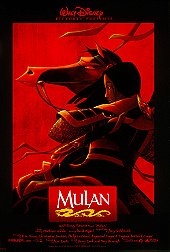Starting with 1992’s Aladdin, Disney produced a series of films which diversified their output during the Renaissance. Typically, a Disney feature is a western Euro-centric musical, slightly homogenous in appearance and style. These stabs at diversification are not without strains and problems, occasionally leaning very hard on coded racial imagery, intentional or not, with lead characters featuring more European features than the villainous and supporting characters.
Mulan is one of the better tries at expanding what a Disney film can look like, or what kind of story it can tell. But like a few other films in the Renaissance, it feels slightly scared of venturing too far out of safe waters. This is what I have a hard time separating in my mind, I keep thinking about the movie Disney could have made instead of the one that they did.
I don’t think I can be entirely blamed for this, the seeds for a more daring and adventurous film are right there. The original folktale, or the most well-known version, has a young girl cutting her hair, taking her father’s place in the army, and becoming a highly decorated and trusted warrior, returning home after a dozen years a hero, and shocking China after discarding her male disguise to reveal their greatest hero was a warrior woman. It plays with gender conventions, and gives girls a bad ass hero to look up to. Mulan follows this in the broad strokes, but undermines it slightly in the end.
The presence of goofy sidekicks proved problematic in a few other films, notably The Hunchback of Notre Dame, and Mulan has a similar problem going for it. Cri-kee and Mushu are nowhere to be found in the original tale, additions to increase revenue and merchandising opportunities within the studio. I would prefer a version with their absence, Eddie Murphy’s rapid-fire delivery is at odds with the more serious film surrounding it. The cricket just adds nothing to the story, a fact which the film-makers knew during production, but they thought it was cute.
My other major problem with Mulan is the romance, which feels shoe-horned into the narrative. An attraction between the two is fine, but they spend so little time together that the finale’s reunion of the two as some grand statement of love is odd. Maybe even off-putting, as so much of Mulan’s character has been about dismantling the confining gender roles in her society that her character returning to domesticity with the prospect of a handsome husband feels incongruous to her character. There’s no spark to this romance.
A minor problem is the villains, they’re just not very threatening or memorable. They’re an off-screen threat for much of the film, and more boogeymen than anything else. Their appearance is slightly distracting from everything around them. Their grey skin, haute couture fashions, and black eyes with yellow pupils read more as alien than anything else. Which could be read in a distressing manner if you wanted, I suppose. I find it just an odd artistic choice since they look like they wandered in from an Alexander McQueen photoshoot.
While I find these facets of the film off-putting, everything else about Mulan works well. The animation borrows from Chinese watercolors, giving the smoke patterns massive amounts of swirls and fluidity of movement. The character designs are more simplistic, more angular, but no less expressive, another way Chinese watercolors influenced the art. One musical number literalizes this homage by creating a moving watercolor painting. It’s lovely to look at, and creates several sequences a tremendous bravado and technical skill.
Even better is how Mulan fulfills the promise of the more proactive heroines in these films. While Ariel and Jasmine got side-lined so the boys could save the day, and Pocahontas was a personality-free blank space for various men to project onto, Mulan is the driving and dominating force. Her choices and agency is never called into question, and she frequently calls out sexism against her. Yes, this feels several centuries ahead of its time, and like Western ideology intruding, but I’ll take it if it means better female characters emerging from the studio.
 Login
Login